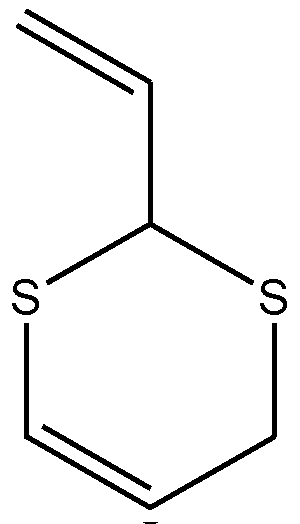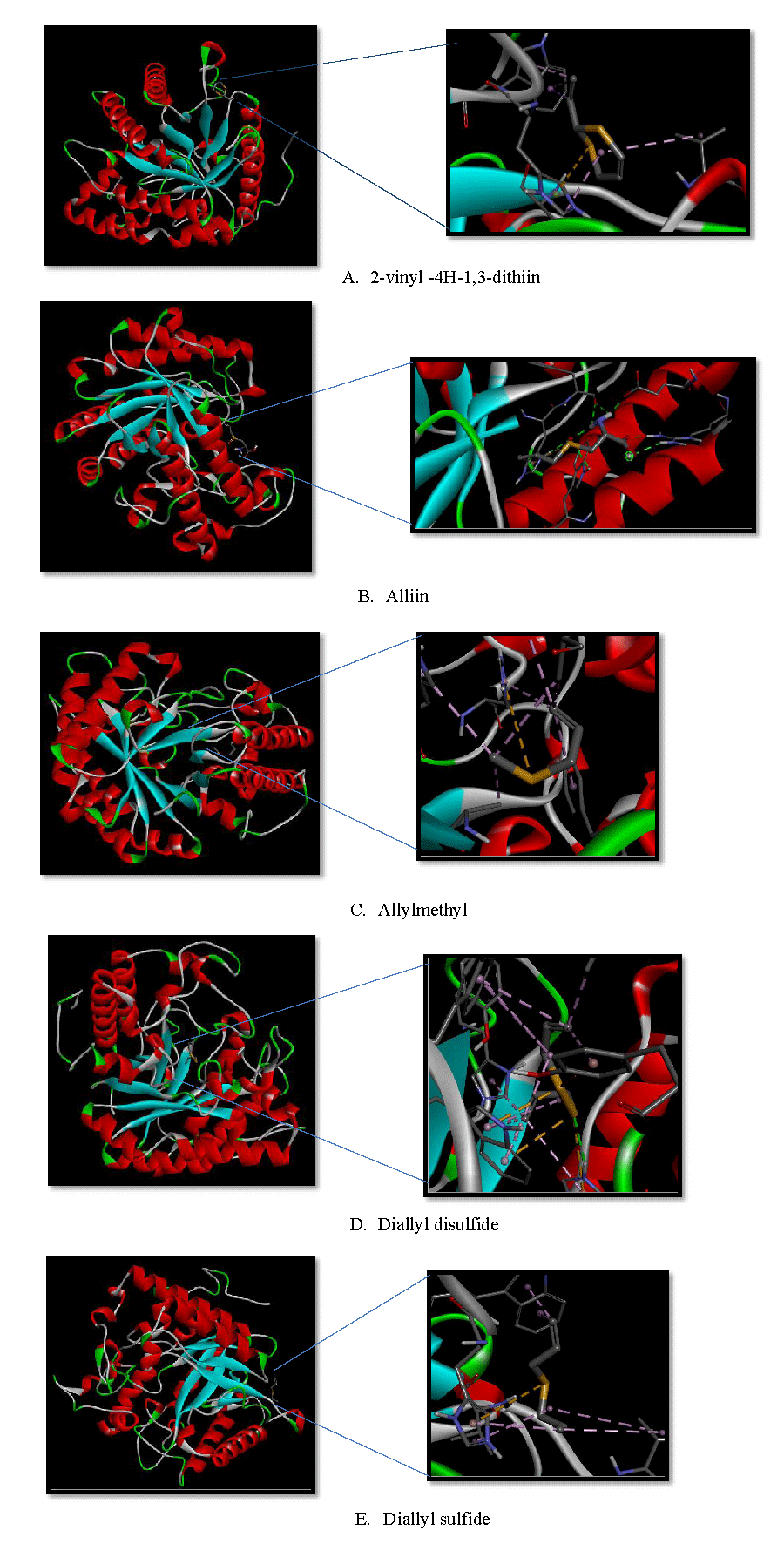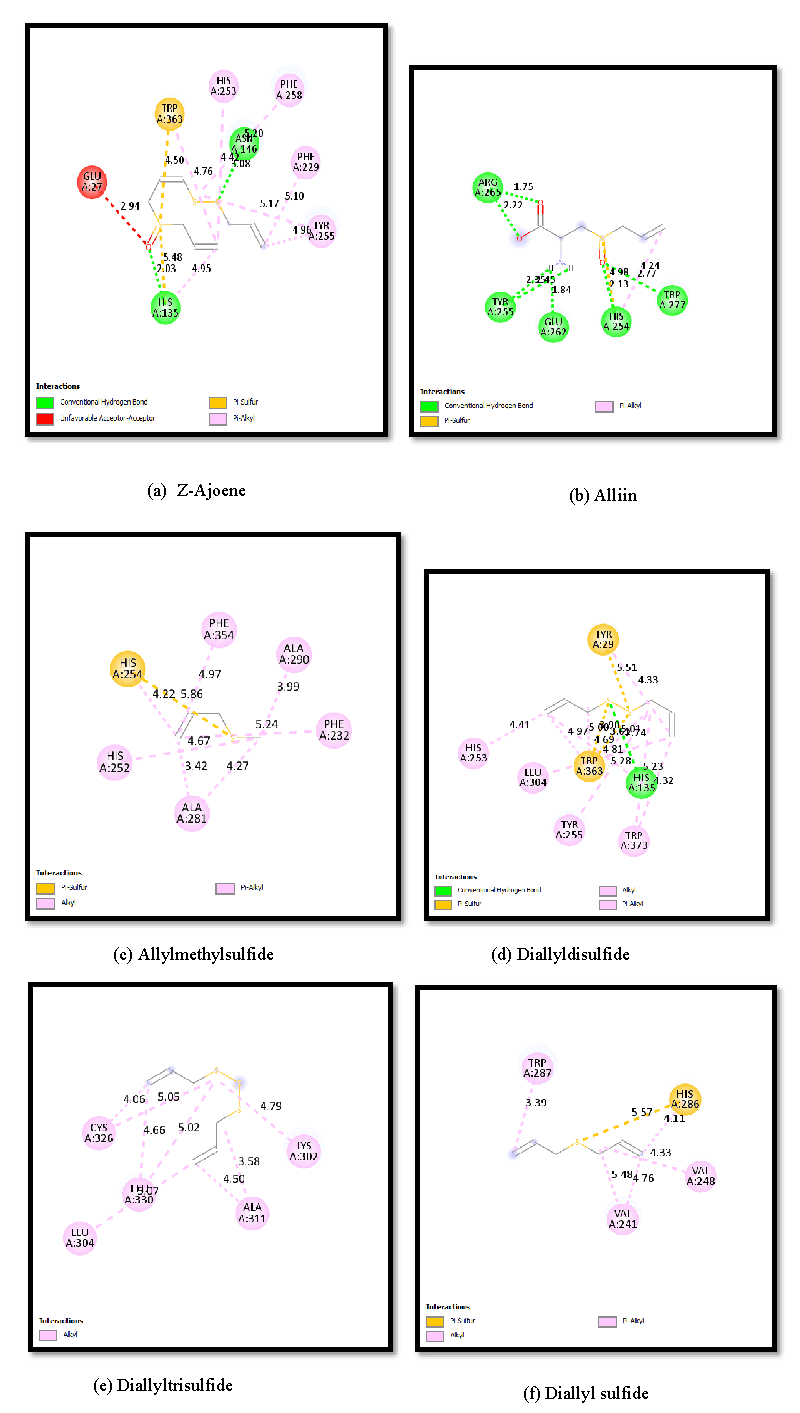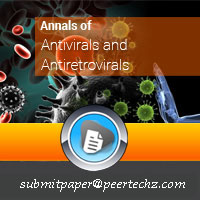Annals of Antivirals and Antiretrovirals
Molecular Docking studies on the Anti-fungal activity of Allium sativum (Garlic) against Mucormycosis (black fungus) by BIOVIA discovery studio visualizer 21.1.0.0
Shaweta Sharma1*, Akhil Sharma2 and Utsav Gupta3
2Principal, R.J College of Pharmacy, Raipur, Aligarh, U.P, India
3Student, Galgotias University, Greater Noida, U.P, India
Cite this as
Sharma S, Sharma A, Gupta U (2021) Molecular Docking studies on the Anti-fungal activity of Allium sativum (Garlic) against Mucormycosis (black fungus) by BIOVIA discovery studio visualizer 21.1.0.0. Ann Antivir Antiretrovir 5(1): 028-032. DOI: 10.17352/aaa.000013Copyright
© 2021 Sharma S, et al. This is an open-access article distributed under the terms of the Creative Commons Attribution License, which permits unrestricted use, distribution, and reproduction in any medium, provided the original author and source are credited.Background: The COVID-19 pandemic is a major concern. However, its association and rising cases of mucormycosis, also known as black fungus make the scenario even more troublesome. In addition, no specific medication against mucormycosis/black fungus makes things even worse.
Objective: Garlic phytoconstituents have shown remarkable antifungal properties against various fungal species in various studies. Thus, the objective of the study was to check the potency of garlic phytoconstituents against the 1,3-beta-glucan synthase fungal protein using in-silico methods.
Method: Auto Dock was used to evaluate selected garlic phytochemical molecules against 1,3-beta-glucan synthase fungal protein, and Discovery studio visualizer was used to create 3D and 2D interaction photos.
Results: Five out of 9 phytoconstituents were found to form conventional hydrogen bonds, and only alliin formed the highest number of hydrogen bonds. However, the binding energy and inhibition constant of all nine phytoconstituents were determined. Interestingly, Z-ajoene showed the lowest binding energy of -5.07 kcal/mol and inhibition constant of 192.57µM.
Conclusion: The results of our investigation suggested that garlic phytochemicals can have a good impact against black fungi, pertaining to the significant binding energies of phytoconstituents during blind docking. Specifically, Z-ajoene could be a good alternate against black fungi. However, detailed research is required to explore the antifungal activity of garlic against mucormycosis.
Introduction
COVID-19, a devastating pandemic disease, is currently wreaking havoc worldwide. However, another illness wreaking havoc on the country is known as “black fungus,” sometimes known as “mucormycosis.” Black fungal illness has piqued people’s interest in tandem with discussions about COVID-19. This disease has been declared a pandemic in various states, including Maharashtra and Gujarat, as well as Rajasthan. Doctors discovered that this fungus only infects people with extremely impaired immune systems, such as COVID-19 patients with diabetes or high uncontrolled blood sugar levels following recovery. Black fungus is a rare fungal infection that affects one out of every 10,000 people but has a 50% fatality rate. The indiscriminate use of steroids for the treatment of COVID-19 patients has been identified as a probable cause of infection. The use of steroids in COVID-19 patients reduced inflammation in the lungs when the body’s immune system was fighting the virus, but uncontrolled use of steroid doses reduced immunity and raised blood glucose levels due to less physical activity in diabetic and nondiabetic people, increasing the risk of contracting black fungal infection. In severely immune-compromised persons, a black fungal infection can attack the sinuses, lungs, and brain, and can be life-threatening. Blackish discoloration around the nose, bleeding, and stuffy nose; black crusts in the nose, loosening of teeth, jaw involvement, one-sided facial pain or numbness, and swelling in the eyes; drooping of eyelids; pleural effusion, worsening of respiratory symptoms, and blurred loss of vision are the most commonly observed symptoms [1,2]. Inhibition of 1,3-glucan production by inhibitor medications such amphotericin/echinocandins decreased fungal growth and consequently replication, according to Zavrel and White (2020) [3]. Due to fungicidal medicine clinical limits, high cost, unavoidable toxicities, and the emergence of drug resistance, the development of effective and safe fungicidal treatments based on novel antifungal targets is urgently required [4]. The major pharmacological compounds that limit 1,3-glucan production have been proposed as potential treatment medicines for fungal infections [5]. It is a glucosyl-transferase enzyme that helps fungi make beta-glucan, which is an important component of cell walls. Because no such structure exists in humans, a previous study suggested that 1,3-beta-glucan synthase could be a promising target for antifungal medication development. [6,7]. Here, we present our perspective on the potential use of bioactive compounds of garlic as a potential treatment modality for black fungus by targeting a 1,3-beta-glucan synthase fungal enzyme.
Garlic (Allium sativum L.; Amaryllidaceae) is a fragrant herbaceous annual spice that has been used as a traditional medicine since ancient times [8,9]. It is the second most widely used Allium species, after onion (Allium cepa L.), and is used to treat a variety of ailments, including the common cold, influenza, snake bites, and hypertension [10]. Allium species and active components have been shown to lower the risk of diabetes and cardiovascular disease, protect against infections by activating the immune system, and have antimicrobial, antifungal, antiaging, and anticancer properties, according to epidemiological data from human clinical trials [11]. We hypothesize that garlic phytochemicals have the capability to prevent black fungal infection. Therefore, the research objective of the current study was in-silico analysis and molecular docking studies pertaining to garlic phytochemicals in relation to 1,3-beta-glucan synthase. As a result of the current study’s findings, researchers will be able to identify the most effective fungicidal agents during COVID-19 treatment Table 1.
Materials and methods
Ligand preparation
PubChem was used to obtain the SDF files of the phytochemicals, and discovery visualizer was utilized for converting the SDF files into PDB files. SDF files cannot be used directly for docking studies.
Molecule preparation
PDB web citation (https://www.rcsb.org/) was used to obtain X-ray crystal structures of 1,3-beta-glucan synthase (PDB ID: 4m80). First, the Auto Dock Tool (ADT) was used to remove all HOH molecules from the protein, assign hydrogen polarities, and add Kollman charges and polar hydrogen atoms. Gasteiger charges were also applied to the prepared protein and the 4m80 protein structure file PDB to 4m80 PDBQT conversion.
Analysis of In-silico interaction
MGL tools Autodock 4.2. software approaches were used to predict the interaction energies between medicinal compounds and COVID-19 proteins. Interactions were analysed using the Lamarckian genetic approach (LGA). AutoDock uses the method below to compute the ligand and receptor interaction binding energy (DG):
ΔGbinding = ΔGgauss + ΔGrepulsion + ΔGhbond + ΔGhydrophobic + ΔGtors
The dispersion of two Gaussian functions is referred to as ΔGgauss. Grepulsion: the square of the distance is repelled if the distance is larger than a threshold value. Ghbond: a ramp function that may be used to model metal ion interactions. ΔGhydrophobic: ramp function, Gtors: proportional to the number of rotatable bonds [19].
During the modification of the native PDB file of the chosen 3D structure of 1,3-beta-glucan synthase (PDB ID: 4m80), water (HOH) was also removed. The pharmaceutical compounds were given hydrogen atoms, Kollman unified charges, default solvation parameters, and a Gasteiger charge in all nine docking studies. In all docking experiments, the grid box was intended toenclose the maximum area of the protein, resulting in blind docking. The values for the X, Y, and Z axes of a grid point were set to 1260 X 1260 X 1260. In the default setting, the grid point spacing was set to 0.575. The Lamarckian genetic algorithm (LGA) was utilized to calculate flexible docking calculations between protein and medicinal molecules [20]. The default LGA parameters were set to 150, 2,500,000, 27,000, 0.02, 0.8, and 0.2, for population size (ga pop size), energy evaluations (ga num generation), mutation rate, crossover rate, and step size, respectively. A total of ten LGA runs were permitted. The obtained conformations of selected 1,3-beta-glucan synthase proteins and drug complexes were subjected to additional analysis and were thoroughly examined for the formation of various types of interactions using Discovery Studio 2019 molecular visualization software after the docking steps were completed successfully (Figure 1).
Result
We discovered that all nine phytochemicals interact with 1,3-beta-glucan synthase proteins in some way after looking at molecular interaction findings from docking experiments with various drugs. The final intermolecular energy, inhibition constants, and hydrogen bond formation during the interaction of medicines and receptor molecules could all be used to evaluate molecular docking data (Figure 2, Table 2).
During blind docking of all nine phytochemicals, it was observed that 5 phytochemicals out of 9 were found to form conventional hydrogen bonds, and out of 5, it was observed that only alliin formed the highest number of hydrogen bonds. However, the binding energy and inhibition constant of all nine phytochemicals were determined, as shown in Table 1. Interestingly, Z-ajoene showed the lowest binding energy of -5.07 kcal/mol and inhibition constant of 192.57µM. However, the binding energy shown in table is due to mainly because of the chemical interactions which were depicted in Figure 2. Basically because of the chemical interaction bonds like covalent bond, alkyl bonds, pi bonds, Hydrogen bonds were formed which justify the protein-ligand binding stability.
Discussion
The interaction energies evaluated from in-silico tests using garlic phytochemicals against 1,3-beta-glucan synthase (PDB ID: 4m80) revealed that all nine garlic phytochemicals interacted with 1,3-beta-glucan synthase. Garlic phytochemicals have good antifungal properties, and it has been observed in many studies that they work by interrupting the fungal cell wall [12-17]. Similarly, the results of our investigation suggest that garlic phytochemicals can have a good impact on black fungi. All the phytochemicals showed significant binding energies during blind docking. As a result, garlic phytochemicals and Z-ajoene can be a good medicine for black fungi. Hence, we recommend that more research be done to see that it has antifungal activity against black fungus [18,19].
- Garg D , Muthu V , Sehgal IS , Ramachandran R , Kaur H, et al. (2021) Coronavirus Disease (Covid-19) Associated Mucormycosis (CAM): Case Report and Systematic Review of Literature. Mycopathologia 186: 289-298. Link: https://bit.ly/2YJBtYA
- Sharma AD, Kaur I (2021) Targeting β-glucan synthase for Mucormycosis “The 'black fungus” maiming Covid patients in India: computational insights. Journal of Drug Delivery and Therapeutics 11: 9–14. Link: https://bit.ly/30ldLSY
- Zavrel M, White TC (2015) Medically important fungi respond to azole drugs: an update. Future Microbiol 10: 1355–1373. Link: https://bit.ly/3DbPtsP
- Cuenca-Estrella M (2014) Antifungal drug resistance mechanisms in pathogenic fungi: from bench to bedside. Clin Microbiol Infect 20: 54–59. Link: https://bit.ly/3qB9ZQt
- Chen X, Zhang Z, Chen Z, Li Y, Su S, et al. (2020) Potential Antifungal Targets Based on Glucose Metabolism Pathways of Candida albicans. Frontiers in Microbiology 11. Link: https://bit.ly/3c52eJZ
- Gong Y, Li T, Yu C, Sun S (2017) Candida albicans Heat Shock Proteins and Hsps-Associated Signaling Pathways as Potential Antifungal Targets. Frontiers in Cellular and Infection Microbiology 7. Link: https://bit.ly/30hMXTf
- Han X, Zhu X, Hong Z, Wei L, Ren Y, et al. (2017) Structure-Based Rational Design of Novel Inhibitors Against Fructose-1,6-Bisphosphate Aldolase from Candida albicans. J Chem Inf Model 57: 1426–1438. Link: https://bit.ly/3c1flMi
- Ayaz E, Alpsoy HC (2007) [Garlic (Allium sativum) and traditional medicine]. Turkiye Parazitol Derg 31: 145–149. Link: https://bit.ly/309Y00V
- Singh Badal D, Azad CS, Kumar V, Singh S, Prakash A, et al. (2019) Effect of organic manures and inorganic fertilizers on growth, yield and its attributing traits in garlic (Allium sativum L.). Journal of Pharmacognosy and Phytochemistry 8: 587–590. Link: https://bit.ly/3omFxqj
- Barnes J, Anderson LA, Phillipson JD (2002) Herbal Medicines, 2nd ed. Pharmaceutical Press: London, UK.
- Rahman K (2001) Historical Perspective on Garlic and Cardiovascular Disease. The Journal of Nutrition 131: 977S-979S. Link: https://bit.ly/3n8mwJ1
- El-Saber Batiha G, Magdy Beshbishy A, Wasef LG, Elewa YHA, Al-Sagan AA, et al. (2020) Chemical Constituents and Pharmacological Activities of Garlic (Allium sativum L.): A Review Nutrients 12: 872. Link: https://bit.ly/30hUdPI
- Fufa BK (2019) Anti-bacterial and Anti-fungal Properties of Garlic Extract (Allium sativum): A Review. Microbiology Research Journal International 1–5. Link: https://bit.ly/309YEvn
- Kuda T, Iwai A, Yano T (2004) Effect of red pepper Capsicum annuum var. conoides and garlic Allium sativum on plasma lipid levels and cecal microflora in mice fed beef tallow. Food Chem Toxicol 42: 1695–1700. Link: https://bit.ly/3kuhbdh
- Pai ST, Platt MW (1995) Antifungal effects of Allium sativum (garlic) extract against the Aspergillus species involved in otomycosis. Lett Appl Microbiol 20: 14–18. Link: https://bit.ly/3FavefW
- Pârvu M, Moţ CA, Pârvu AE, Mircea C, Stoeber L, et al. (2019) Allium sativum Extract Chemical Composition, Antioxidant Activity and Antifungal Effect against Meyerozyma guilliermondii and Rhodotorula mucilaginosa Causing Onychomycosis. Molecules 24: 3958. Link: https://bit.ly/3qwja4k
- Zhen H, Fang F, Ye D, Shu S, Zhou Y, et al. (2006) Experimental study on the action of allitridin against human cytomegalovirus in vitro: Inhibitory effects on immediate-early genes. Antiviral Research 72: 68–74. Link: https://bit.ly/3kq4d03
- Morris GM, David SG, Robert SH, Ruth H, William EH, et al. (1998) Automated docking using a Lamarckian genetic algorithm and an empirical binding free energy function. Journal of Computational Chemistry 19: 1639–1662. Link: https://bit.ly/3CcBEZU
- Morris GM, Huey R, Lindstrom W, Michel FS, Richard KB et al. (2009) AutoDock4 and AutoDockTools4: Automated docking with selective receptor flexibility. Journal of Computational Chemistry 30: 2785–2791. Link: https://bit.ly/3Dew62s
- https://autodock.scripps.edu/. (n.d.).
- https://www.3ds.com/products-services/BIOVIA/products/molecular-modeling-simulation/BIOVIA-discovery-studio/visualization. (n.d.).
Article Alerts
Subscribe to our articles alerts and stay tuned.
 This work is licensed under a Creative Commons Attribution 4.0 International License.
This work is licensed under a Creative Commons Attribution 4.0 International License.










.gif)
.gif)

.gif)

 Save to Mendeley
Save to Mendeley
